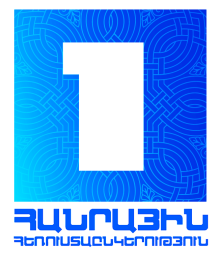Public Television Company of Armenia
Public Television of Armenia (Armenian: Հայաստանի Հանրային Հեռուստաընկերություն, 1TV), Hayastani Hanrayin Herrustaynkerut’yun; also known as Armenia 1, ARMTV or APMTV, is Armenia's public television station that began transmissions in 1956.
 Armenian Public TV/1TV | |
| Type | Free-to-air radio, television and online |
|---|---|
| Country | |
| Headquarters | Yerevan |
| Owner | Public TV |
Launch date | 1956 (television) |
Picture format | 720p HDTV |
Official website | www |
History
Early years
Armenia Public Television dates back to September 5, 1955 when the USSR Council of Ministers made the decision to construct 27 programme centres and five transmission stations in the Union Republics. On 29 November 1956, the date of Sovietization of Armenia, the first programme of Armenian television was transmitted.
The official opening of the Armenian television took place on February 9, 1957 as regular programmes began to air. Later that year on August 6, 1957 the first news programme was transmitted, titled the News of the Week. At first the news programme was not periodical, but by February, 1958 the news programme became periodical, which resulted in the creation of the news editorial office.
On October 13, 1957 the State Committee on Radio and Television Programmes of the Council of Ministers of the Armenian Soviet Socialist Republic was formed. According to the decree of the USSR Supreme Soviet issued in December, 1970, The State Committee on Radio transmission and Television was renamed to the All-Union Republican State Committee on Television and Radio Transmission.
In March 1973 the television station began its preparations for the changeover to transmissions in colour. Engineers for a colour mobile station, TV production laboratory, video recording units were obtained to begin this process. On May 1, 1973 the station made its first colour transmission from Lenin Square for the May Day Parade. Initially, the colour programmes were transmitted only from the mobile station, from the large celebrations, concerts, sport events of the country. Starting from 1978 about 50 percent of the programmes of the first and the second Armenian channels were in colour. Starting in August, 1973, the first video recordings were broadcast, which made 70 percent of the programmes in 1978.
In November 1977 a new 311.7 metres (1,023 feet) high television tower was erected, as well as "Orbita-2" - a space communication station, which transferred the second programme of the Central Television from Moscow. In 1978 it became possible to see also the fourth channel of the Central Television in Armenia.
1990 to today
As political powers began changing in 1990, the then prime minister, Vazgen Manukyan, appointed Henrik Hovhannisyan, a non-communist, to be the head of the State Department of Television and Radio programmes. He started the reformation of the Armenian television, both in terms of content and structure. Those changes were called to comply with the situation of the Kharabagh Freedom movement, and the breakdown of USSR.
Armenia declared its independence on September 21, 1991. A month later, the president of the country signed the RA Law "On Mass Media". For the first time in Armenia the information system had an opportunity to develop in a free and favourable environment. The freedom of speech and purely national propaganda were predominant for the Armenian television.
The economic crisis of the country seriously influenced the functioning of the National television. Capacity were significantly cut and the quantity of viewers decreased. According to the data of November–December 1993, the statistical TV audience was 27.4%.
In November 1996 the 40th anniversary of the Armenian television was celebrated with festivities. The national television continued to preserve with great difficulty what has been created during the former years. The bulk of the programs were entertainment and comedy programs.
In 1996 the second channel of the Armenian television separated and became a separate program. Robert Mavisakalyan was appointed director of Nork television. Within a short period of time "Nork" was able to attract the attention of the bulk of the audience.
According to the Law of the Republic of Armenia "On Television and Radio" in force from 2000, the Public television shall start broadcasting all of its programs, films in Armenian starting from January 1, 2005. The public television started working on the process of translating programmes into Armenian even before the law was adopted. A translation studio equipped with special acoustic and film cutting equipment was created.
New roads and prospects opened for the Armenian Public Television in 2005. The Armenian Public Television and Radio were recognized full and equal members of the European Broadcasting Union at the 56th General Assembly of the European Broadcasting Union held in Dubrovnik on July 7 and July 8. Becoming an Active Member of the European Broadcasting Union, Armenia gained the right to take part in the Eurovision Song Contest, which during the 50 years had already become a favorite event for the Europeans.[1]
See also
- Media of Armenia
- Public Radio of Armenia
- Television in Armenia
References
- "Encyclopedia of the First". 2007-05-04. Archived from the original on 2007-04-05.